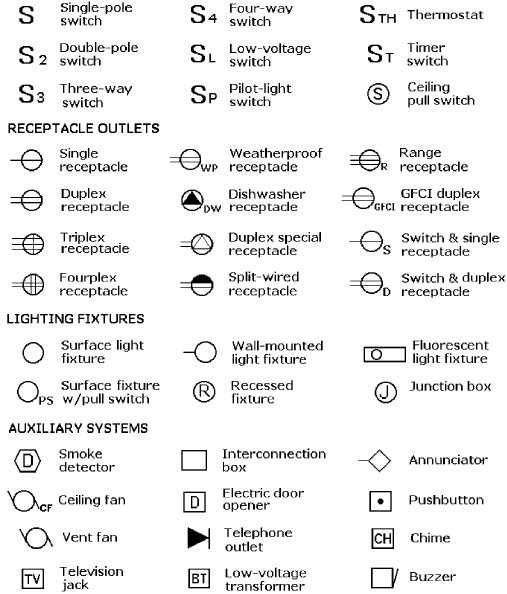Ever wondered how electricians decipher those intricate diagrams that map out the electrical systems in our homes and buildings? It's like a secret language, and the key to understanding it lies in deciphering the electrical symbols used in electrical plans. These symbols are more than just simple markings; they are the essential building blocks of electrical design, allowing professionals to communicate complex electrical layouts clearly and concisely.
Electrical plan symbols represent various electrical components, from simple switches and outlets to complex circuit breakers and transformers. Imagine trying to build a house without a blueprint. Similarly, electrical symbols serve as the blueprint for electrical installations, providing a visual roadmap for electricians to follow. They are the universal language of electrical engineering, ensuring consistency and accuracy in electrical projects worldwide.
The history of electrical symbols is intertwined with the development of electricity itself. As electrical systems became more complex, the need for a standardized system of representation arose. Early electrical diagrams were often crude and varied, leading to confusion and misinterpretations. Over time, organizations like the International Electrotechnical Commission (IEC) and the Institute of Electrical and Electronics Engineers (IEEE) played a crucial role in standardizing electrical symbols, ensuring uniformity and clarity across the globe.
The importance of accurately interpreting electrical symbols cannot be overstated. Misinterpreting even a single symbol can lead to costly mistakes, safety hazards, and project delays. These symbols are crucial for ensuring the safety and functionality of electrical systems. They allow electricians to understand the wiring layout, identify potential hazards, and troubleshoot problems efficiently.
One of the main issues related to electrical symbols is the sheer number and variety of symbols used in electrical plans. With different standards and variations across regions, it can be challenging for professionals to stay up-to-date with the latest symbols and their interpretations. Continuing education and access to reliable resources are essential for electricians and engineers to maintain proficiency in understanding these symbolic representations.
A simple example is the symbol for a single-pole switch. It resembles a small break in a line, representing the switch's ability to open or close the electrical circuit. Another common symbol is the grounded outlet, represented by a circle with three lines extending from it, signifying the hot, neutral, and ground wires.
Benefits of using electrical symbols include improved communication, reduced errors, and enhanced safety. Standardized symbols ensure that everyone involved in an electrical project understands the plan, minimizing misinterpretations. Clear communication leads to fewer errors during installation, saving time and resources. Furthermore, accurate electrical plans enhance safety by allowing electricians to identify potential hazards and implement appropriate safety measures.
Advantages and Disadvantages of Using Electrical Symbols
| Advantages | Disadvantages |
|---|---|
| Clear and concise communication | Requires knowledge and training to interpret |
| Reduces errors and rework | Variations in standards can cause confusion |
| Enhances safety and prevents accidents | Constant updates and revisions require ongoing learning |
Best practices for using electrical symbols include adhering to established standards (like IEC or IEEE), using clear and legible diagrams, and providing a legend to explain the meaning of each symbol. Regularly updating your knowledge of electrical symbols and utilizing software tools designed for electrical drafting can also improve accuracy and efficiency.
Frequently Asked Questions:
1. What is the symbol for a resistor? (A zigzag line)
2. What does a circle with a cross inside represent? (A light fixture)
3. How is a three-phase motor symbolized? (A circle with an "M" inside)
4. What does GFCI stand for and what is its symbol? (Ground Fault Circuit Interrupter, a rectangle with "GFCI" inside)
5. What is the symbol for a transformer? (Two coils facing each other)
6. How is a normally open contact represented? (Two parallel lines with a gap)
7. What is the difference between the symbols for a fuse and a circuit breaker? (A fuse is typically a rectangle with a wire inside, while a circuit breaker is a more complex symbol often resembling a switch.)
8. Where can I find a comprehensive list of electrical symbols? (IEC and IEEE websites, electrical engineering handbooks)
Tips and tricks for working with electrical symbols include using online resources and software tools that offer symbol libraries and automated drafting features. These tools can significantly improve efficiency and accuracy in creating and interpreting electrical plans.
In conclusion, electrical symbols used in electrical plans are fundamental to effective electrical design, installation, and maintenance. Understanding these symbols is not just about deciphering a technical language; it's about ensuring safety, efficiency, and accuracy in electrical projects. By mastering this symbolic language, electricians and engineers can effectively communicate complex electrical designs, prevent errors, and contribute to building safer and more reliable electrical systems. Continuing education, adherence to established standards, and leveraging available resources are crucial for professionals to stay current with the ever-evolving world of electrical symbols and contribute to a future powered by safe and efficient electrical systems. Embrace the language of electricity and empower yourself to create a brighter future, one symbol at a time.
Toyota rav4 for sale ni conquer the emerald isle
Navigating justice philadelphia municipal court online
Understanding graded compensation systems













